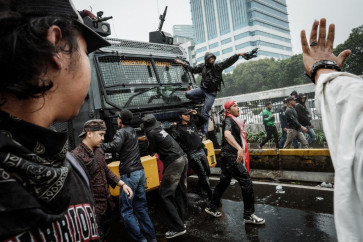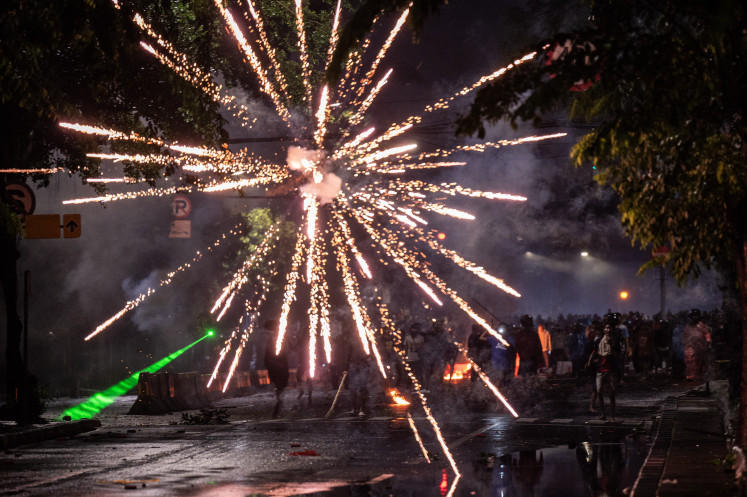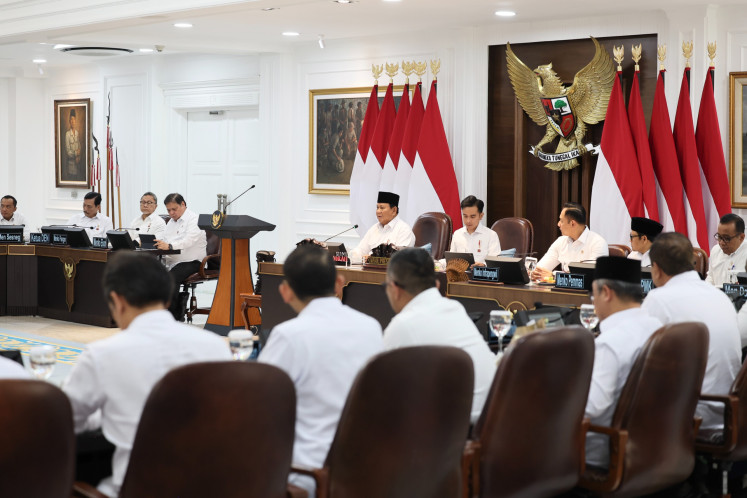Popular Reads
Top Results
Can't find what you're looking for?
View all search resultsPopular Reads
Top Results
Can't find what you're looking for?
View all search resultsJakarta performing arts scene: Making Noise
Domestic tension: Slamet Rahardjo (left) and actress Artasya Sudirman (right) share the stage during a play titled Suara-suara Mati (The Voices of Death)
Change text size
Gift Premium Articles
to Anyone
D
span class="caption">Domestic tension: Slamet Rahardjo (left) and actress Artasya Sudirman (right) share the stage during a play titled Suara-suara Mati (The Voices of Death). (Courtesy of Salihara Community/Witjak Widhi Cahya)
The capital city’s performing arts scene has shown some oomph this year, bustling with eye-opening, mind-rousing staging of eclectic expressions in words, art, music and movement.
World famous Raise the Red Lantern by the National Ballet of China, the highly acclaimed I Bislacchi — A Tribute to Fellini by Italian dance company Artemis Danza, the Vienna Boys Choir, the Korean non-verbal Bibap dance and comedy performance, the collaborative Once ballet gala by the West Australian Ballet company and Indonesian dancers, Shakespeare’s rework Rosalind ballet by James Cousins Company under a collaboration between British and South Korean dancers, as well as Broadway musicals Shrek and Annie were among the performances in Jakarta that gained public attention.
The year also marked the return of big names in the national theater scene, besides Teater Koma, which has a strong fan base and performs two to three titles every year. Putu Wijaya’s Teater Mandiri staged in April Zera, a comedy on happiness, while Teguh Karya’s Teater Populer — now led by Slamet Rahardjo — performed Suara-suara Mati (The Voices of Death) in early December.
As the host of various local and international events, from conventional performing arts such as dance recitals, theater, opera and orchestra to avant-garde performance arts, Jakarta took a step forward in becoming the art hub of the region.
It was the ultimate goal of the current Jakarta Arts Council, which has put on a string of art events, artist workshops and public discussions during its working term that started mid-year and will run until 2018.
With younger, talented artists taking over councillor seats, they moved fast in capturing world trends in music and theater hovering below the radar and presented them to the public, while at about the same time establishing the city’s own symphony orchestra — the Jakarta City Philharmonic — due for a monthly concert since November.
The council, however, was not alone in bringing life back to the art scene. Many institutions contributed to the heartening year, such as the biennial Indonesian Dance Festival, the pre-event of the Indonesia Art Summit, the annual Salihara International Performing Arts Festival and the first UK/ID Festival held by the British Council, besides the regular programs at Galeri Indonesia Kaya.
“It has been a busy year with more new productions on stage and new talents rising,” said poet, art curator and cultural critic Nirwan Dewanto, who directed the Salihara cultural center festival for the past four years.
“Although we brought international groups here to expand the horizons of our local artists and the public, the works of our local artists are not to be undermined by comparison.”
As one of the judges at the art council’s Jakarta Theater Festival, Nirwan said many of the theater troupes taking part in the competition injected new, non-theatrical elements into their performances.
“However, we could only see them at festivals. It’s understandable because these small groups share the common problem of finding operational funds,” he said.
Under the light: UK dance group James Cousins Company presented Rosalind, a reworking of William Shakespeare’s As You Like It, at Usmar Ismail Hall in South Jakarta on Oct. 25. (JP/Jerry Adiguna)
BIG TASK AHEAD
Afrizal Malna, theater committee head at the arts council, corroborated the notion on the pulsating art scene, especially with regard to performance art.
“The young artists are tired of the conventional one-way presentation of an idea and therefore are inserting new elements to engage the audience. It is a phenomenon that comes with the development of digital media where the user can interact with the viewers in real time.
“Jakarta has shown some progress, but it’s still far behind other cities such as Surakarta, Bandung and Yogyakarta. Jakarta lacks theatrical events and city murals compared to those cities.”
He said the theater committee would work closely with other arts and cultural institutions.
Themed “Transition”, the Jakarta Theater Festival this year focused on this change, leading to the committee’s program for next year in which it will establish an ecosystem of performing and performance art scenes — the artists, the financial backers and the audience — not only in Jakarta but nationwide.
Under the big theme “Evacuation”, Afrizal said theater communities starting next year would find solutions to existing problems hampering the development of performing and/or performance arts.
“If there is no way out, then we should move out from this emergency situation to a safe place. We will simply evacuate,” he said with a laugh.
Theater communities have a big task ahead that will include “educating” the public, Nirwan says.
“These kind of performances are still only for niche markets and are not taking place regularly. Jakarta is definitely no New York, where the people are used to musicals, even realism drama as their choice of entertainment.”
Another problem, he said, was the lack of attention from the government in regard to the operational funds of theater groups.
“In order to survive, some artists create performances with international appeal to ensure a premier and get sponsors for the production. Even if government funds are allocated for the arts, they are given sporadically and are not part of its regular budget.
Nirwan underlines the importance of closer collaboration with the government.
“To develop the performing arts and performance arts scenes in Jakarta, the Jakarta Arts Council can’t work alone, it has to better cooperate with the government,” he said.











